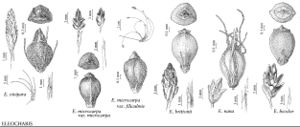Eleocharis nana
Enum. Pl. 2: 140. 1837.
Plants probably perennial, tufted; rhizomes present, ± horizontal, 0.3–0.5 mm thick, soft, longer internodes 5 mm, scales disintegrating, translucent or not. Culms erect to ascending, ± quadrangular to pentagonal or broadly elliptic, sometimes sulcate, (1.9–) 4.2–8.6 cm (extraterritorial plants to 12 cm) × 0.2–0.4 mm, soft. Leaves: distal leaf-sheaths persistent or fugaceous, pale-brown or redbrown sometimes spotted or streaked-redbrown, translucent, membranous, apex acute. Spikelets: basal spikelets absent; never proliferous, ovoid, ellipsoid or obovoid, laterally compressed when young, but terete at maturity, 1.9–4 × 1–3 mm, apex acute, proximal scale empty, deciduous, amplexicaulous or nearly so, similar to floral scales, 0.6–2.5 × 0.8–1.2 mm, midrib sometimes slightly prolonged beyond lamina; subproximal scale with a flower; floral scales distichous or spirodistichous, (2–) 4–10, 3–5 per mm of rachilla, pale-brown, spotted or streaked-redbrown, ovate or elliptic, 1.7–2.2 × 0.4–0.7 mm, membranous, midrib green, spotted redbrown, prominent, apex rounded. Flowers: perianth bristles 6, redbrown, equaling to much exceeding tubercle; spinules sparse, retrorse, sharply acute; stamens 3; anthers 0.5–0.7 × 0.1 mm; styles 3-fid. Achenes whitish or pale-brown, circular in outline, ellipsoid, or obovoid, trigonous, angles prominent, 0.6–0.8 × 0.5–0.6 (–0.7) mm, apex constricted proximal to tubercle, smooth. Tubercles white or redbrown, pyramidal, trigonous, 0.2–0.4 × 0.3–0.4 mm.
Phenology: Fruiting summer–winter.
Habitat: Freshwater, moist terrestrial sites such as sandy and peaty ponds, cypress swamps
Elevation: 10–50 m
Distribution

Fla., South America
Discussion
H. K. Svenson (1957) described Eleocharis nana as “annual (?),” but the presence of rhizomes suggests that this species may be perennial.
Selected References
None.
Lower Taxa
"shortened" is not a number."prolonged" is not a number.
